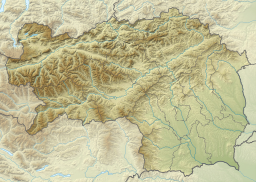| Grüner See | |
|---|---|
 | |
| Location | Tragöß, Styria, Austria |
| Coordinates | 47°32′30″N 15°3′21″E / 47.54167°N 15.05583°E |
| Basin countries | Austria |
| Max. depth | up to 12 m (39 ft) |
Grüner See (Green Lake) is a lake in Styria, Austria in a village named Tragöß, which is part of the municipality Tragöß-Sankt Katharein. The lake is surrounded by forests and three mountains: Pribitz (1,579 m), Meßnerin (1,835 m) and Trenchtling (Hochturm) (2,081 m), all part of the Hochschwab Mountains.[1] The name "Green Lake" originated because of its emerald-green water.[1] The clean and clear water comes from the snowmelt from the karst mountains and has a temperature of 6–7 °C (43–45 °F).[1] During winter, the lake is only 1–2 m (3–7 ft) deep and the surrounding area is used as a county park.[citation needed]
However, in spring, when the temperature rises and snow melts, the basin of land below the mountains fills with water.[citation needed] The lake reaches its maximum depth of around 12 m (39 ft) from mid-May to June and is claimed to look the most beautiful at this time.[1] In July, the water begins to recede.[citation needed]
The lake supports a variety of fauna such as snails, water fleas (Daphnia pulex), small crabs, fly larvae, and different species of trout (Salmo).[1] The flora is not abundant because of the rocky bottom of the lake.[1] Furthermore, the lake's depth is variable since its inflow comes from snowmelt.[1]
The lake was popular among divers who could observe the green meadows in the edge zone of the lake particularly in June when the water is at its highest.[1] A bridge and a bench could also be found underwater.[1] Furthermore, trails and trees could also be seen underwater.[2]
Because of the spike in tourist visits that has occurred and expected damage to this sensitive environment, the use of this lake for all watersports activities has been prohibited since 1 January 2016.[3]
Gallery
References
- ^ a b c d e f g h i Nicola Rampazzo; Franz Ottner; Franz Zehetner; Axel Mentler; Winfried E. H. Blum (2008). "Altitudinal Soil Sequence In The Austrian Northern Calcareous Alps" (PDF). Eurosoil. Archived from the original (PDF) on 23 August 2011. Retrieved 10 May 2011.
- ^ "This Was Just An Ordinary Park Last Week. Now, It's The Most Beautiful Lake Ever". The San Diego Herald. 2014. Archived from the original on 14 July 2014. Retrieved 5 July 2014.
- ^ "Austria's Green Lake Closes for Divers". Dive Magazine.
Further reading
- Bretschko G (1966). "Der Grüne See bei Tragöß, Steiermark. Ein Beitrag zur Karstlimnologie". Internationale Revue der gesamten Hydrobiologie und Hydrographie (in German). 51 (5): 699–726. doi:10.1002/iroh.19660510503.
External links
- Grüner See (Green Lake) Scuba Diving 2013 on YouTube. Retrieved 18 May 2013.
- Amazing and Beautiful Flooded Meadow on YouTube. Retrieved 10 May 2011.
- "Grüner See". gruenersee.at. Retrieved 10 May 2011.





